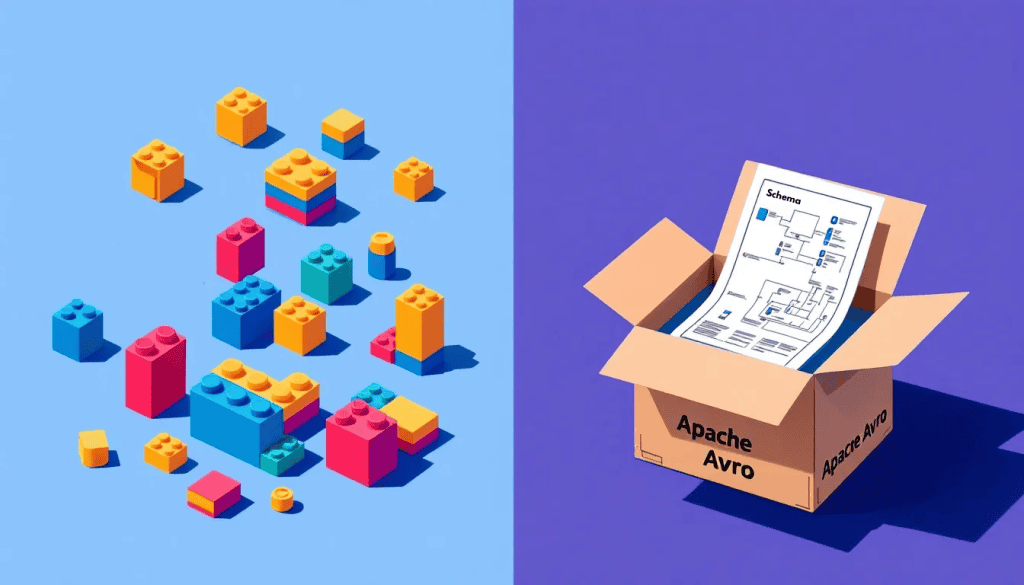
What is Data Serialization?
Think of serialization like sending a complex LEGO structure to a friend via snail mail. You can’t ship the assembled structure as-is because it might break during transit. Instead, you disassemble it, pack the pieces with instructions, and send it off. Upon arrival, your friend uses those instructions to rebuild the exact same structure.
In programming, serialization works the same way. It’s the process of breaking down complex data structures or objects into a format that can be easily stored or transmitted, like converting them into a series of bytes. This serialized data can then be saved to a file, sent over a network, or stored in a database. When needed, deserialization reconstructs the original object from this data.
Real World Examples
Machine Learning Model Storage
Perhaps you’ve pickled a model? After training a machine learning model, it’s common to save the model for future use without retraining. But you also need to track metadata like model version, accuracy scores, training timestamps, and hyperparameters.
You could serialize all this metadata into an .avro file alongside your pickled model. Later, your deployment pipeline reads the .avro file to verify the model meets performance thresholds before pushing to production.
import pickle
from avro.datafile import DataFileWriter, DataFileReader
from avro.io import DatumWriter, DatumReader
import avro.schema
# train and save your model
trained_model = train_my_model()
with open("spam_classifier.pkl", "wb") as f:
pickle.dump(trained_model, f)
# save metadata to Avro
schema = avro.schema.parse('''
{
"type": "record",
"name": "ModelMetadata",
"fields": [
{"name": "model_name", "type": "string"},
{"name": "version", "type": "string"},
{"name": "accuracy", "type": "float"},
{"name": "f1_score", "type": "float"}
]
}
''')
with DataFileWriter(open("model_metadata.avro", "wb"), DatumWriter(), schema) as writer:
writer.append({
"model_name": "spam_classifier",
"version": "v2.1",
"accuracy": 0.94,
"f1_score": 0.91
})
# deployment pipeline - verify before deploying
with DataFileReader(open("model_metadata.avro", "rb"), DatumReader()) as reader:
metadata = next(reader)
# check performance thresholds
if metadata["accuracy"] >= 0.90 and metadata["f1_score"] >= 0.85:
# load and deploy the model
with open("spam_classifier.pkl", "rb") as f:
model = pickle.load(f)
print(f"✅ Deploying {metadata['model_name']} {metadata['version']}")
else:
print("❌ Model doesn't meet performance thresholds. Deployment blocked.")Streaming User Events in Kafka
Let’s say you’re building an analytics platform that tracks user behavior. Every time a user clicks a button, watches a video, or makes a purchase, that event needs to flow through Kafka to your data warehouse.
Instead of sending JSON blobs, you serialize each event as an .avro file with a schema defining fields like user_id, event_type, timestamp, and metadata. As your product evolves and you need to add fields like session_id or device_type, Avro handles it gracefully. Your downstream consumers don’t break, and you’re storing data way more efficiently than JSON.
from avro.datafile import DataFileWriter, DataFileReader
from avro.io import DatumWriter, DatumReader
import avro.schema
import time
# load your event schema
event_schema = avro.schema.parse(open("user_event.avsc", "rb").read())
# serialize events to Avro instead of JSON
with DataFileWriter(open("user_events.avro", "wb"), DatumWriter(), event_schema) as writer:
# user watches a video 🎥
writer.append({
"user_id": "user_12345",
"event_type": "video_watch",
"timestamp": int(time.time() * 1000),
"metadata": '{"video_id": "v_789", "duration": 120}'
})
# user makes a purchase 💸
writer.append({
"user_id": "user_12345",
"event_type": "purchase",
"timestamp": int(time.time() * 1000),
"metadata": '{"item_id": "prod_456", "price": 29.99}'
})
# consumer reads events
with DataFileReader(open("user_events.avro", "rb"), DatumReader()) as reader:
for event in reader:
print(f"User {event['user_id']} performed {event['event_type']}")Why Avro over JSON, Protobuf, or CSV files?
Avro is a language-neutral, compact, schema-driven data serialization framework designed for high-performance data exchange. It was developed within the Apache Hadoop ecosystem, and you’ll often see it used in big data pipelines, Kafka topics, and anywhere you need efficient, evolution-friendly data serialization.
What Makes Avro Special?
Schema Evolution Without the Headaches
Here’s where Avro really shines. Let’s say you have a data pipeline that’s been running for months. Your User schema has fields like username, email, and created_at. Now your product team wants to add a premium_tier field. With Avro, you can add that new field to your schema, and your existing data doesn’t break!
Are there old records without premium_tier? No problem, Avro handles the missing field gracefully using default values. This is called schema evolution and it’s a lifesaver when you’re working with production data that you can’t just delete and recreate.
Compare that to CSV files where adding a column means every downstream process needs updating, or JSON where you’re constantly writing defensive code to check if fields exist. Avro schemas give you that contract between your data producers and consumers.
Compact and Fast
Avro stores data in a binary format, which makes it significantly more space-efficient than JSON or …XML 🤢. If you’re dealing with millions of records flowing through your data lake or streaming through Kafka, those bytes add up fast. Your storage costs will thank you.
The binary format also means faster serialization and deserialization. Less data to transfer = less network latency = more impressed stakeholders.
Self-Describing Data
Each Avro file includes its schema, which means the file itself tells you exactly what fields exist and what types they are. You don’t need a separate schema registry or documentation wiki to understand your data (though having one is still a good idea for governance). The data speaks for itself.
When Should You Use Avro?
Avro is great for:
- Data pipelines where schemas might evolve over time.
- High-throughput streaming applications (like Kafka).
- Long-term data storage where you need backward compatibility.
- Cross-language data exchange (for example: Python writes, Java reads, while Scala processes).
Avro might be overkill for:
- Data pipelines where schemas might evolve over time.
- High-throughput streaming applications (like Kafka).
- Long-term data storage where you need backward compatibility.
- Cross-language data exchange (for example: Python writes, Java reads, while Scala processes).
Here’s The Deal
Is Avro the Swiss Army Knife for all serialization problems? Nope. It has a learning curve, especially if you’re used to the simplicity of JSON. The binary format means you can’t just cat a file and read it like you would with CSV or JSON. You’ll need Avro tools to inspect your data.
But if you’re building data infrastructure that needs to scale and evolve, Avro is absolutely worth learning. It’s used in production environments at companies processing petabytes of data, and once you get over that initial learning curve, you’ll appreciate the guardrails it provides.
Next time your team is designing a new data pipeline or debating serialization formats, you’ll have the context to make an informed decision. And who knows? You might be the one advocating for Avro 😉.
